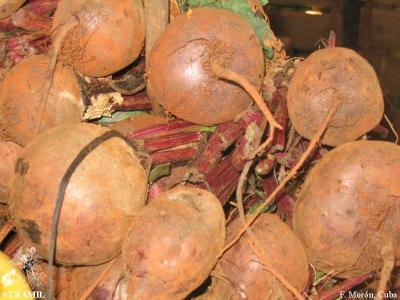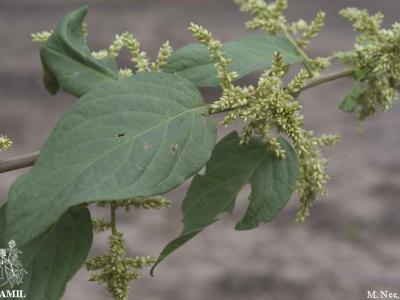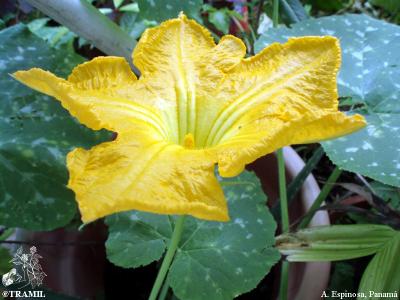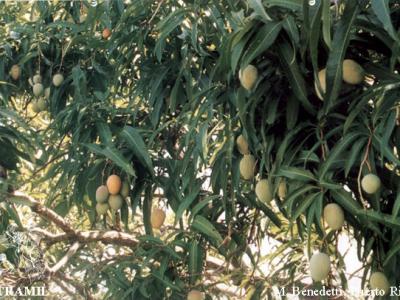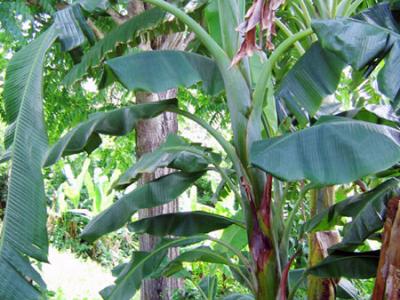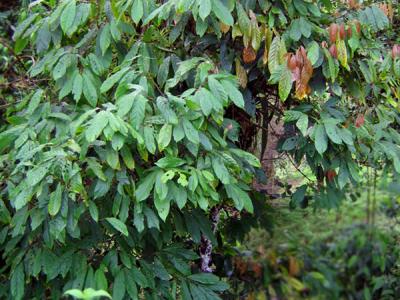(In territories with significant traditional TRAMIL use)
Haiti:
- bètrouj
Dominican Republic:
- remolacha
root, juice, orally with sugar and/or with honey and/or with milk1-3
According to the information available:
The use for delayed menstruation (amenorrhoea), asthenia and weakness is classified as REC based on the significant traditional use documented in the TRAMIL surveys and the scientific information published.
Due to the health risk of asthenia and weakness, an initial medical assessment is recommended. The use of this resource must be considered complementary to medical treatment, unless contraindicated.
Because of its antithyroid activity, boiled root administered orally may interact or potentially interfere with thyroid treatments.
Not for use during pregnancy because it can cause miscarriage, nor while breastfeeding.
The tuber (root) of Beta vulgaris is a food of relatively widespread human consumption and is an industrial source of sucrose.
For asthenia, weakness or delayed menstruation:
Wash the fresh raw tuber well. Prepare 100 millilitres of juice. Drink fresh 1 or more times a day30.
Preparations must never be stored for more than 24 hours, even if refrigerated.
1 WENIGER B, ROUZIER M, 1986
Enquête TRAMIL. Service Oecuménique d’Entraide SOE, Port au Prince, Haïti.
2 GERMOSEN-ROBINEAU L, GERONIMO M, AMPARO C, 1984
Encuesta TRAMIL. enda-caribe, Santo Domingo, Rep. Dominicana.
3 WENIGER B, 1987-88
Encuesta TRAMIL. enda-caribe, Santo Domingo, Rep. Dominicana.
4 CHIERICI L, 1953
Allantoin and tyrosine in beets. Ateneo Parmense 24:185-188.
5 DUBBELS R, REITER RJ, KLENKE E, GOEBEL A, SCHNAKENBERG E, EHLERS C, SCHIWARA HW, SCHLOOT W, 1995
Melatonin in edible plants identified by radioimmunoassay and by high performance liquid chromatography-mass spectrometry. J Pineal Res 18(1):28-31.
6 TYIHAK E, 1964
Effective component in the effect of the red beet (Beta vulgaris var conditiva) on tumors. Naturwissenschaften 51:315-316.
7 IKEKITA M, MORIYA H, MORIWAKI C, RURIKAWA T, 1979
Some properties of anti-bradykinin substance from beet (Beta vulgaris L. var rapa Dumort. f rubra DC.) roots. Yakugaku Zasshi 99:607-611.
8 NEURATH GB, DUNGER M, PEIN FG, AMBROSIUS D, SCHREIBER O, 1977
Primary and secondary amines in the human environment. Food Cosmet Toxicol 15(4):275-282.
9 PARFENENKO VV, BUZINA GV, LUTSENKO OK, 1974
Production of gel-forming beet pectin in the presence of 1.1% hydrochloric acid. Khlebopek Konditer Prom 1974(10):20.
10 CHOLLET MM, 1950
Sucrose and raffinose in beets. Bull Soc Bot Fr 1950:173-177.
11 PIATTELLI M, MINALE L, PROTA G, 1965
Pigments of centrospermae. III. Betaxanthins from Beta vulgaris L. Phytochemistry 4:121-125.
12 GEORGIEV VG, WEBER J, KNESCHKE EM, DENEV PN, BLEY T, PAVLOV AI, 2010
Antioxidant activity and phenolic content of betalain extracts from intact plants and hairy root cultures of the red beetroot Beta vulgaris cv. Detroit dark red. Plant Foods Hum Nutr 65(2):105-111.
13 HERRMANN K, 1957
Oxidative enzymes and phenolic substrate in vegetables and fruit. I. Hydroxycinnamic acids. Z Lebensm-Unters Forsch 106:341-348.
14 BURBA M, NITZSCHKE U, 1974
Oxalic acid in sugar beet roots. Int Sugar J 76:326.
15 TAKAHASHI H, SASAKI T, ITO M, 1987
New flavonoids isolated from infected sugar beet roots. Bull Chem Soc Japan 60(6):2261-2262.
16 ELLIGER CA, HALLOIN JM, 1994
Phenolics induced in Beta vulgaris by Rhizoctonia solani infection. Phytochemistry 37(3):691-693.
17 YOSHIKAWA M, MURAKAMI T, KADOYA M, MATSUDA H, MURAOKA O, YAMAHARA J, MURAKAMI N, 1996
Medicinal foodstuffs. III. Sugar beet. (1): Hypoglycemic oleanolic acid oligoglycosides, betavulgarosides I, II, III, and IV, from the root of Beta vulgaris L. (Chenopodiaceae). Chem Pharm Bull 44(6):1212-1217.
18 YOSHIKAWA M, MURAKAWI T, KADOYA M, YAMAHARA J, MATSUDA H, 1998
Medicinal foodstuffs. XV. Sugar beet. (2): Structures of betavulgarosides V, VI, VII, VIII, IX, and X from the roots and leaves of sugar beet (Beta vulgaris L., Chenopodiaceae). Chem Pharm Bull 46(11):1758-1763.
19 KUJALA TS, LOPONEN JM, KLIKA KD, PIHLAJA K, 2000
Phenolics and betacyanins in red beetroot (Beta vulgaris) root: distribution and effect of cold storage on the content of total phenolics and three individual compounds. J Agric Food Chem 48(11):5338-5342.
20 DUKE JA, ATCHLEY AA, 1986
Handbook of proximate analysis tables of higher plants. Boca Raton, USA: CRC Press, p26.
21 MORON F, 1990
Actividades biológicas de Beta vulgaris. Informe TRAMIL. Laboratorio Central de Farmacología, Facultad de Medicina “Dr. Salvador Allende”, Instituto Superior de Ciencias Médicas de La Habana, La Habana, Cuba.
22 CARBALLO A, RODRIGUEZ A, RODRIGUEZ O, LLENDERROZOS A, 1992
Efectividad de la administración del zumo de raíces de remolacha (Beta vulgaris L.) en el control de la astenia. Estudio clínico controlado. Informe TRAMIL. Instituto Superior de Ciencias Médicas. Santa Clara, Cuba.
23 PRAHOVEANU E, ESANU V, ANTON G, FRUNZULIC S, 1986
Prophylactic effect of a Beta vulgaris extract on experimental influenza infection in mice. Rev Roum Med Virol 37(2):121-124.
24 JOSEPH H, GRANDGUILLOTTE M, 1986
Recherches bibliographiques. SNPG, Guadeloupe. TRAMIL II, Santo Domingo, República Dominicana, UASD/enda-caribe.
25 RAO VSN, DASARADHAN P, KRISHNALAH KS, 1979
Antifertility effect of some indigenous plants. Indian J Med Res 70:517-520.
26 NAVRATIL B, ZEMAN L, 1976
Effect of the daily ration and the type of complete mixed feed fed to pregnant sows on the number and weight of piglets. Zivocisna Uyrpba 21:295-303.
27 ELBE JH, SCHWARTZ SJ, 1981
Absence of mutagenic activity and an short-term toxicity study of beet pigments as food colorants. Arch Toxicol 49:93-98.
28 VAN DER WALT SJ, STEYN DG, 1946
Recent investigations into the toxicity of plants, etc.XV. Onderstepoort J Vet Sci Animal Ind 21(1):45-55.
29 GREER MA, ASTWOOD EB, 1948
The antithyroid effect of certain foods in man as determined with radioactive iodine. Endocrinology 43:105-119.
30 VANACLOCHA B, CAÑIGUERAL S, (eds.) 2003
Beta vulgaris. En: Fitoterapia. Vademecum de Prescripción. 4ta Edición. Editorial MASSON, Barcelona, España, p428.


